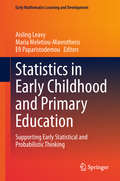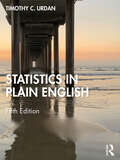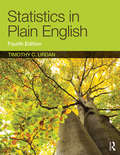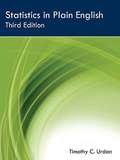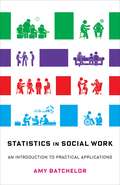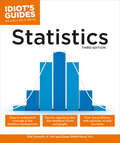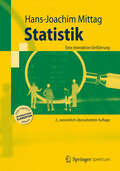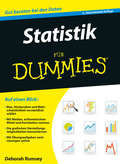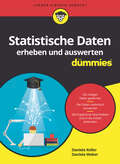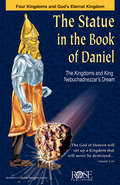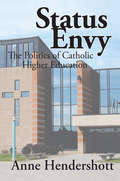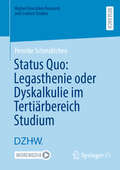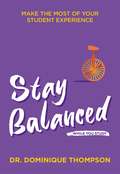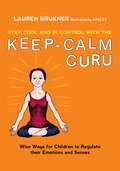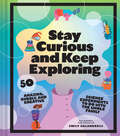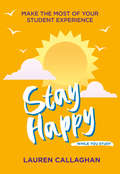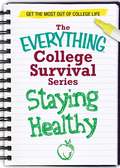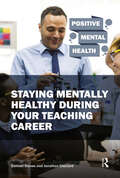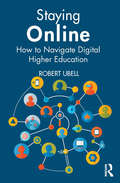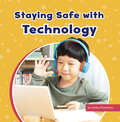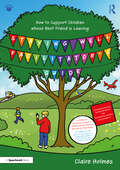- Table View
- List View
Statistics in Early Childhood and Primary Education: Supporting Early Statistical and Probabilistic Thinking (Early Mathematics Learning and Development)
by Aisling Leavy Maria Meletiou-Mavrotheris Efi PaparistodemouThis compilation focuses on the theory and conceptualisation of statistics and probability in the early years and the development of young children’s (ages 3-10) understanding of data and chance. It provides a comprehensive overview of cutting-edge international research on the development of young learners’ reasoning about data and chance in formal, informal, and non-formal educational contexts. The authors share insights into young children’s statistical and probabilistic reasoning and provide early childhood educators and researchers with a wealth of illustrative examples, suggestions, and practical strategies on how to address the challenges arising from the introduction of statistical and probabilistic concepts in pre-school and school curricula. This collection will inform practices in research and teaching by providing a detailed account of current best practices, challenges, and issues, and of future trends and directions in early statistical and probabilistic learning worldwide. Further, it will contribute to future research and theory building by addressing theoretical, epistemological, and methodological considerations regarding the design of probability and statistics learning environments for young children.
Statistics in Plain English
by Timothy C. UrdanStatistics in Plain English is a straightforward, conversational introduction to statistics that delivers exactly what its title promises. Each chapter begins with a brief overview of a statistic (or set of statistics) that describes what the statistic does and when to use it, followed by a detailed step-by-step explanation of how the statistic works and exactly what information it provides. Chapters also include an example of the statistic (or statistics) used in real-world research, "Worked Examples," "Writing It Up" sections that demonstrate how to write about each statistic, "Wrapping Up and Looking Forward" sections, and practice work problems. Thoroughly updated throughout, this edition features several key additions and changes. First, a new chapter on person-centered analyses, including cluster analysis and latent class analysis (LCA) has been added, providing an important alternative to the more commonly used variable-centered analyses (e.g., t tests, ANOVA, regression). Next, the chapter on non-parametric statistics has been enhanced with in-depth descriptions of Mann-Whitney U, Kruskal-Wallis, and Wilcoxon Signed-Rank analyses, in addition to the detailed discussion of the Chi-square statistic found in the previous edition. These nonparametric statistics are widely used when dealing with nonnormally distributed data. This edition also includes more information about the assumptions of various statistics, including a detailed explanation of the assumptions and consequences of violating the assumptions of regression, as well as more coverage of the normal distribution in statistics. Finally, the book features a multitude of real-world examples throughout to aid student understanding and provides them with a solid understanding of how several statistics techniques commonly used by researchers in the social sciences work. Statistics in Plain English is suitable for a wide range of readers, including students taking their first statistics course, professionals who want to refresh their statistical memory, and undergraduate or graduate students who need a concise companion to a more complicated text used in their class. The text works as a standalone or as a supplement and covers a range of statistical concepts from descriptive statistics to factor analysis and person-centered analyses.
Statistics in Plain English, Fourth Edition
by Timothy C. UrdanThis introductory textbook provides an inexpensive, brief overview of statistics to help readers gain a better understanding of how statistics work and how to interpret them correctly. Each chapter describes a different statistical technique, ranging from basic concepts like central tendency and describing distributions to more advanced concepts such as t tests, regression, repeated measures ANOVA, and factor analysis. Each chapter begins with a short description of the statistic and when it should be used. This is followed by a more in-depth explanation of how the statistic works. Finally, each chapter ends with an example of the statistic in use, and a sample of how the results of analyses using the statistic might be written up for publication. A glossary of statistical terms and symbols is also included. Using the author's own data and examples from published research and the popular media, the book is a straightforward and accessible guide to statistics. New features in the fourth edition include: sets of work problems in each chapter with detailed solutions and additional problems online to help students test their understanding of the material, new "Worked Examples" to walk students through how to calculate and interpret the statistics featured in each chapter, new examples from the author's own data and from published research and the popular media to help students see how statistics are applied and written about in professional publications, many more examples, tables, and charts to help students visualize key concepts, clarify concepts, and demonstrate how the statistics are used in the real world. a more logical flow, with correlation directly preceding regression, and a combined glossary appearing at the end of the book, a Quick Guide to Statistics, Formulas, and Degrees of Freedom at the start of the book, plainly outlining each statistic and when students should use them, greater emphasis on (and description of) effect size and confidence interval reporting, reflecting their growing importance in research across the social science disciplines an expanded website at www.routledge.com/cw/urdan with PowerPoint presentations, chapter summaries, a new test bank, interactive problems and detailed solutions to the text's work problems, SPSS datasets for practice, links to useful tools and resources, and videos showing how to calculate statistics, how to calculate and interpret the appendices, and how to understand some of the more confusing tables of output produced by SPSS. Statistics in Plain English, Fourth Edition is an ideal guide for statistics, research methods, and/or for courses that use statistics taught at the undergraduate or graduate level, or as a reference tool for anyone interested in refreshing their memory about key statistical concepts. The research examples are from psychology, education, and other social and behavioral sciences.
Statistics in Plain English, Third Edition
by Timothy C. UrdanThis inexpensive paperback provides a brief, simple overview of statistics to help readers gain a better understanding of how statistics work and how to interpret them correctly. Each chapter describes a different statistical technique, ranging from basic concepts like central tendency and describing distributions to more advanced concepts such as t tests, regression, repeated measures ANOVA, and factor analysis. Each chapter begins with a short description of the statistic and when it should be used. This is followed by a more in-depth explanation of how the statistic works. Finally, each chapter ends with an example of the statistic in use, and a sample of how the results of analyses using the statistic might be written up for publication. A glossary of statistical terms and symbols is also included. New features in the third edition include: a new chapter on Factor and Reliability Analysis especially helpful to those who do and/or read survey research, new "Writing it Up" sections demonstrate how to write about and interpret statistics seen in books and journals, a website at http://www.psypress.com/statistics-in-plain-english with PowerPoint presentations, interactive problems (including an overview of the problem's solution for Instructors) with an IBM SPSS dataset for practice, videos of the author demonstrating how to calculate and interpret most of the statistics in the book, links to useful websites, and an author blog, new section on understanding the distribution of data (ch. 1) to help readers understand how to use and interpret graphs, many more examples, tables, and charts to help students visualize key concepts. Statistics in Plain English, Third Edition is an ideal supplement for statistics, research methods, and/or for courses that use statistics taught at the undergraduate or graduate level, or as a reference tool for anyone interested in refreshing their memory about key statistical concepts. The research examples are from psychology, education, and other social and behavioral sciences.
Statistics in Social Work: An Introduction to Practical Applications
by Professor Amy BatchelorUnderstanding statistical concepts is essential for social work professionals. It is key to understanding research and reaching evidence-based decisions in your own practice—but that is only the beginning. If you understand statistics, you can determine the best interventions for your clients. You can use new tools to monitor and evaluate the progress of your client or team. You can recognize biased systems masked by complex models and the appearance of scientific neutrality. For social workers, statistics are not just math, they are a critical practice tool.This concise and approachable introduction to statistics limits its coverage to the concepts most relevant to social workers. Statistics in Social Work guides students through concepts and procedures from descriptive statistics and correlation to hypothesis testing and inferential statistics. Besides presenting key concepts, it focuses on real-world examples that students will encounter in a social work practice. Using concrete illustrations from a variety of potential concentrations and populations, Amy Batchelor creates clear connections between theory and practice—and demonstrates the important contributions statistics can make to evidence-based and rigorous social work practice.
Statistics, 3E (Idiot's Guides)
by Robert A. Donnelly Fatma Abdel-RaoufStatistics is a class that is required in many college majors, and it&’s an increasingly popular Advanced Placement (AP) high school course. In addition to math and technical students, many business and liberal arts students are required to take it as a fundamental component of their majors. A knowledge of statistical interpretation is vital for many careers. Idiot&’s Guides®: Statistics explains the fundamental tenets in language anyone can understand. Content includes: - Calculating descriptive statistics. - Measures of central tendency: mean, median, and mode. - Probability. - Variance analysis. - Inferential statistics. - Hypothesis testing. - Organizing data into statistical charts and tables.
Statistik
by Hans-Joachim MittagBeim Multimedia-Comenius-Wettbewerb 2011 ausgezeichnet, bietet das Lehrbuch als Kombination aus Druckwerk und interaktiver Online-Fassung eine gelungene Einführung in die Statistik. Das Anwendungsspektrum der Statistik wird anhand aktueller Beispiele illustriert, die statistischen Konzepte in Grafiken visualisiert. Der Band enthält viele Übungsaufgaben mit ausführlichen Lösungen. Die überarbeitete 2. Auflage wird durch neue interaktive Experimente und tongestützte Animationen ergänzt und bietet frei zugängliche Multimedia-Ressourcen im Internet.
Statistik für Dummies (Für Dummies)
by Deborah J. RumseyVon A wie Ausreißer bis Z wie Z-Verteilung Entdecken Sie mit Statistik für Dummies Ihren Spaß an der Statistik und werfen Sie einen Blick hinter die Kulissen dieser komplizierten, aber hilfreichen Wissenschaft! Deborah Rumsey zeigt Ihnen das nötige statistische Handwerkszeug wie Stichprobe, Wahrscheinlichkeit, Bias, Median, Durchschnitt und Korrelation. Sie lernen die verschiedenen grafischen Darstellungsmöglichkeiten von statistischem Material kennen und werden über die unterschiedlichen Methoden der Auswertung erstaunt sein. Schärfen Sie mit diesem Buch Ihr Bewusstsein für Zahlen und deren Interpretation, sodass Ihnen keiner mehr etwas vormachen kann!
Statistische Daten erheben und auswerten für Dummies (Für Dummies)
by Daniela Weber Daniela KellerSie müssen Arbeit mit statistischem Anteil schreiben und wissen nicht recht wie Sie vorgehen sollen, auch wenn Sie über theoretische Kenntnisse in Statistik verfügen? Dann hilft Ihnen dieses Buch. Daniela Weber und Daniela Keller erklären Ihnen Schritt für Schritt wie Sie vorgehen sollten. Sie starten mit den Fragen, die Sie sich schon zu Beginn stellen sollten, erklären dann einige Grundbegriffe und Methoden und erläutern dann wie Sie an die nötigen Daten kommen und diese schließlich auswerten. Zum Schluss erklären Ihnen die Autorinnen wie Sie Ihre Ergebnisse richtig beschreiben. So hilft Ihnen dieses Buch Ihrer Arbeit eine valide statistische Grundlage zu geben.
Statue in the Book of Daniel
by Rose PublishingThe Statue in the Book of Daniel ventures into the fascinating dream of King Nebuchadnezzar in Daniel 2 and Daniel's vision in Daniel 7. This bestselling, ebook includes an illustration of the statue (based on an authentic Babylonian carving of the era) and explores each of the statue's four parts, as well as the four kingdoms they represent. Maps of ancient civilizations, a time line of events and rulers, and a comparison chart help explain the statue's parts and their meaning.What does the statue represent in King Nebuchadnezzar's dream in the second chapter of Daniel? What is it saying about earthly empires and heavenly kingdoms? The Statue in the Book of Daniel pamphlet describes the meaning of the Head of Fine Gold, Chest and Arms of Silver, Belly and Thighs of Bronze, and Feet of Iron and Clay. A map of the ancient world provides context for the kingdoms that are represented by the statue segments, and a time line reveals the rise and fall of kingdoms between 600 BC to 100 AD. Daniel's interpretation speaks to the Scriptural truth that rulers and empires come and go, but God's kingdom, ruled by the Son of Man, will be everlasting.The Statue in the Book of Daniel is an excellent resource for presenting Daniel's prophecy of God's everlasting Kingdom. Daniel's interpretation draws correlations between the elements of the statue:The Head of Fine GoldThe Chest and Arms of SilverThe Belly and Thighs of BronzeThe Feet of Iron and ClayThe rock—not cut out by human hands—which struck and felled the statue. The Statue in the Book of Daniel also provides information on the most powerful nations in the Middle East represented in Daniel's dream:Babylonia Medo-PersiaGreeceA Divided Kingdom (often considered Rome)An illustration of the statue is based on an authentic Babylonian carving. Comparisons between each part include bulleted observations with interesting facts or connections to other Scripture references. The Statue in the Book of Daniel also includes maps outlining the geographical areas of the relevant kingdoms.
Status Envy: The Politics of Catholic Higher Education
by Anne HendershottThe debate within Catholic educational circles on whether church sponsored colleges and universities perpetuate mediocrity by giving too great a priority to the moral development of students instead of scholarship and intellectual excellence continues in this book by sociologist Anne Hendershott. She asserts that part of the reason for the crisis of faith within Catholic colleges is due to status envy--the desire to compete with the top colleges in the country. Catholic universities are generally not rated as top-notch. They are viewed as having a lower status than secular institutions, which, of course, creates resentment. Catholic universities, in turn, become more secular as they become consumed with status concerns. Detailing how this resentment manifests itself on campuses, Hendershott explains faculty and administrative attempts to distance universities from Catholic ideas and curriculum. Some have distanced themselves so far from their Catholic origins that the church no longer recognizes them as Catholic institutions. The author questions whether even determined Catholic universities will be able to avoid the pressures to become more secular. Hendershott, who clearly sympathizes with the original mission of Catholic universities, leads the reader through the earliest signs that Catholic colleges were beginning to lose their way in the 1960s, up through the ongoing issues of feminism and homosexuality and their impact. In focusing on these secular issues, colleges are denying exposure to the traditional Catholic views on subjects such as homosexuality, women's ordination, and abortion. Like all culture wars, the interaction among people defines the situation. The campus is a reflection of the greater culture between those who assert that there are no truths, only readings--and those who believe that the truths have been revealed and require constant rereading and application. It is a conflict between those dedicated to the negation of the authority of Scripture and the hierarchy of the church, and those proposing a renaissance of the Catholic intellect and a renewed appreciation of the church itself.
Status Quo: Legasthenie oder Dyskalkulie im Tertiärbereich Studium (Higher Education Research and Science Studies)
by Henrike SchmidtchenMenschen mit Legasthenie und Dyskalkulie sind an deutschen Hochschulen stark unterrepräsentiert und die Forschung zu diesem Thema ist rar. Eine gleichberechtigte und diskriminierungsfreie Teilhabe von Studierenden mit studienerschwerenden Beeinträchtigungen gemäß der UN-Behindertenrechtskonventionen kann durch die Hochschulen allerdings nur sichergestellt werden, wenn wissenschaftlich fundierte Ergebnisse in den Prozess bis hin zur 2009 von der Hochschulrektorenkonferenz geforderten „Hochschule für alle“ einfließen. In diesem Buch wird untersucht, wie sich der Tertiärbereich Studium in der Bildungskarriere von Personen mit den Teilleistungsstörungen Legasthenie oder Dyskalkulie gestaltet und gibt damit erstmals einen Überblick über den Status Quo dieser Studierendengruppe. Die inhaltlich-strukturierende qualitative Inhaltsanalyse zeigt, dass Studierende mit Legasthenie und Dyskalkulie bereits hilfreiche individuelle Ressourcen beispielsweise in Form von Lern- und Copingstrategien nutzen und auch den an Hochschulen gesetzlich-verankerten Nachteilsausgleich teils als unterstützend empfinden. Dennoch sind die befragten Studierenden - nicht zuletzt durch die Covid-19-Pandemie – auf diversen Ebenen mit verschiedensten Herausforderungen konfrontiert, die zu psychischer Belastung und Studienerschwernissen führen können.
Stay Balanced While You Study: Make the Most of Your Student Experience
by Dominique ThompsonWant to make the most of being a student?Award-winning mental health specialist, Dr Dominique Thompson, explores issues around leaving home, exam stress, socialising, safety, sex, and drugs, to help you succeed and truly enjoy your time as a student.Complemented by insights from real students, this useful guide provides credible advice, practical tips, and exercises to safely navigate the unique pressures and opportunities that student life brings. Easy-to-read, visually appealing and convenient to carry with you, it's a non-judgemental toolkit for happiness and confidence.Stay Balanced While You Study is the ultimate companion for school-leavers planning ahead for university, as well as a handy addition for those already in higher and further education.
Stay Cool and In Control with the Keep-Calm Guru: Wise Ways for Children to Regulate their Emotions and Senses
by Apsley Lauren BruknerMeet the Keep-Calm Guru, our expert guide to the art of staying cool, calm, and in control in the face of overpowering feelings! This illustrated book introduces wise ways for children to recognize and cope with anxiety, anger, frustration, and other difficult emotions. Using everything from yoga poses and pressure holds, to deep breathing and relaxing coloring activities, the Keep-Calm Guru shows kids how to take back control and feel cool, calm, and just right. Suitable for children with sensory and emotional regulation difficulties aged approximately 7-14 years.
Stay Curious and Keep Exploring: 50 Amazing, Bubbly, and Creative Science Experiments to Do with the Whole Family
by Emily CalandrelliFrom the host of Netflix's Emily's Wonder Lab and FOX's Xploration Outer Space comes a book featuring 50 experiments that introduce the wonders of science to the whole family. MIT engineer Emily Calandrelli shares the science behind each experiment while showing you where to find STEAM concepts in the world around you. You'll learn how to think like a scientist with Make a Hypothesis! and Try This! prompts, where you can experiment within the experiment. With Calandrelli's expert guidance, illustrations throughout, and easy-to-find grocery items, you can make: An alien hovercraft to learn how an air hockey table worksGlow in the dark paint to learn about ultraviolet lightDelicious ice cream to learn about supercoolingOobleck to learn why ketchup is so hard to get out of the bottle With chapters like Magic Tricks, Kitchen Science, and Fun with Physics, this book is packed with experiments that will delight little scientists and their lab assistants. Grab your goggles and a family member to get started on a journey to spark curiosity, critical thinking, and fun family times!
Stay Happy While You Study: Make the Most of Your Student Experience (Student Wellbeing Series)
by Lauren CallaghanPrioritizing your studies, social life and everything in between - all while looking after yourself - can sometimes mean your levels of happiness are overlooked.Written by Clinical Psychologist Lauren Callaghan, this guide will help you to stay happy and harness useful mood-boosting tools so that you can successfully navigate your way through the unique pressures and opportunities that student life brings.Complemented by insights from real students, this book is easy-to-read, convenient to carry, and a valuable toolkit for sustained confidence and well-being.Stay Happy While You Study is the ultimate companion for school-leavers planning ahead for university, as well as a handy addition for those who are already studying in higher and further education.
Staying Healthy
by Adams MediaGet ready for the best years of your life! College Survival: Staying Healthy contains everything you need to know to always feel your best. With advice from avoiding the dreaded "Freshman 15," to coping with homesickness, to navigating campus health services, you'll be on top of your game all semester long.
Staying Healthy: Get the most out of college life
by Adams MediaGet ready for the best years of your life! College Survival: Staying Healthy contains everything you need to know to always feel your best. With advice from avoiding the dreaded "Freshman 15," to coping with homesickness, to navigating campus health services, you'll be on top of your game all semester long.
Staying Human During Residency Training
by Allan D. PeterkinThe ultimate survival guide for medical students, interns, residents and fellows, Staying Human during Residency Training provides time-tested advice and the latest information on every aspect of a resident's life - from choosing a residency program, to coping with stress, enhancing self-care, and protecting personal and professional relationships.Allan D. Peterkin, MD, provides hundreds of tips on how to cope with sleep deprivation, time pressures, and ethical and legal issues. This fifth edition features new, leading-edge information on enhancing personal resilience, planning one's career, pursuing leadership roles, and using new technologies to maximize learning. Presenting practical antidotes to cynicism, careerism, and burnout, Peterkin also offers guidance on fostering more empathic connection with patients and deepening relationships with colleagues, friends, and family.Acknowledged by thousands of doctors across North America as an invaluable resource, Staying Human during Residency Training has helped to shape notions of trainee well-being for medical educators worldwide. Informative, compassionate, and professional, this new edition will again show why it is required reading for medical students and new physicians pursuing postgraduate training.
Staying Mentally Healthy During Your Teaching Career (Positive Mental Health)
by Jonathan Glazzard Samuel StonesThe mental health of teachers in school is just as important as the well-being of the pupils they support. Recent research reveals some alarming statistics, including that 74% of teachers are unable to relax and have a poor work-life balance. This book examines a range of relevant issues including workload, managing behaviour, developing resilience and managing professional relationships in order to address some of these concerns and provide comprehensive guidance and workable, evidence-informed strategies to support all those teaching in schools and colleges.
Staying Online: How to Navigate Digital Higher Education
by Robert UbellIn Staying Online, one of our most respected online learning leaders offers uncommon insights into how to reimagine digital higher education. As colleges and universities increasingly recognize that online learning is central to the future of post-secondary education, faculty and senior leaders must now grapple with how to assimilate, manage, and grow effective programs. Looking deeply into the dynamics of online learning today, Robert Ubell maps its potential to boost marginalized students, stabilize shifts in retention and tuition, and balance nonprofit and commercial services. This impressive collection spans the author’s day-to-day experiences as a digital learning pioneer, presents pragmatic yet forward-thinking solutions on scaling-up and digital economics, and prepares managers, administrators, provosts, and other leaders to educate our unsettled college students as online platforms fully integrate into the mainstream.
Staying Safe with Technology (Take Care of Yourself)
by Ashley RichardsonTechnology is all around us all the time. Readers will learn ways to stay safe while using technology and important steps to take if they run into problems.
Staying Well Activity Book: Practical Activities to Support Children Aged 7-12 whose Best Friend is Leaving (Staying Well)
by Claire HolmesCoping when a friend moves away is hard. This book is designed to help ‘the stayers’ (those left behind) manage this big change. Perfect for children aged 7–12, it’s jam-packed full of activities that invite the reader to use their creativity by annotating and illustrating the pages. This makes the book unique to each child, helping them feel a greater sense of agency and control at a time of change.The text acknowledges change is stressful and the child is encouraged to think about their own responses to change and build their coping repertoire. The concept of TRUST is introduced, an acronym for five key things to ‘stay well’. The reader explores what each letter stands for and considers how paying attention to these can help make their process smoother. The book concludes with activities that bring together the child’s journey through the pages, helping to solidify their learning and engagement with the text.Best introduced around eight weeks before the friend leaves, this is a must-have resource to help children ‘stay well’. Grounded in wellbeing and transition research, this activity book contains much wisdom for adults too.
Staying Well Facilitator's Guide: How to Support Children whose Best Friend is Leaving (Staying Well)
by Claire HolmesCoping when a friend moves away is hard. The Staying Well Facilitator’s Guide contains guidance notes, prompts, and bonus material that helps the facilitator bring out the best experience for the child using the Staying Well Activity Book. This practical guide can be used to support one child or a group of children by parents, class teachers, learning support teachers, and counsellors. Support material is included to help the lead-adult feel confident in their delivery and in responding to questions related to the discussion.Every page in the Staying Well Activity Book has a corresponding page in the Staying Well Facilitator’s Guide for the user to refer to when delivering the material, each of which features:• A page rationale which touches on the theory behind the activity.• A visual of the corresponding page.• Materials needed.• How to set the scene.• How to complete the activity.• Facilitator’s top tips.• How to close the activity.• Possible extension activities.Grounded in wellbeing and transition research, this guide is an invaluable companion to the Staying Well Activity Book, helping a lead-adult support children whose best friend is moving away.
